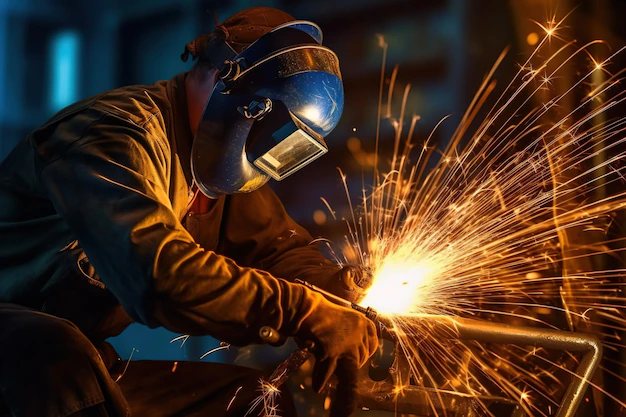How to Weld D-Rings?

Introdution
How to Weld D-Rings? Welding D-rings is a relatively straightforward process that requires welding equipment and suitable materials. Before you start, wear the proper safety gear, such as a face shield, gloves, and long sleeves to help safeguard against splatter.
After donning your safety gear, you’re ready to begin welding. Start by prepping the D-ring for welding; ensure that both pieces of metal are clean, free from dirt and debris, and properly aligned. Use a file to remove any rust or corrosion before welding.
Next, set up your welding equipment according to manufacturer instructions. Make sure to adjust the settings for the metal you’re welding with and the thickness of the D-ring.
Welding D-rings can be helpful whether you’re a hobbyist or a professional welder. With the correct tools and protection, anybody can master welding. Make sure to carry out regular practice sessions for safety and skill enhancement!
What does D-ring?

Have you ever heard of a D-ring? Ever wonder what it meant or what purpose it served? A D-ring is an attachment device that can be used for various purposes, such as buckling straps and hanging items like heavy bags. It’s simple to use and offers unbeatable strength when attached securely!
D-ring stands for “delta ring” because of its triangular shape.t is also occasionally known as D-hook or O-ring, depending on its specific condition. This invaluable tool, including camping gear and furniture hardware, can be found everywhere. It’s an incredibly versatile and reliable piece of hardware that you’ll find yourself reaching for repeatedly.
You’ll find that D-rings come in many configurations, such as wire D-rings and S-hooks. The most common type is the regular D-ring made of metal or plastic. They can also be customized with other items like clips and hooks to ensure a secure fit.
TYPES OF D-RINGS
Are there different types of coatings available for D-Rings?
When it comes to coatings, there are numerous alternatives ready for use. Nonetheless, the most popular choice remains a universal favorite: coating. Types are zinc plating, powder coating, and anodizing. Zinc plating offers excellent corrosion resistance, while powder coating provides a sleek look and improved durability. Anodizing helps protect the metal from wear and tear over time.
No matter which coating you choose, make sure it’s suitable for the environment in which your D-ring will be used. For the best longevity and performance of your D-ring and coating, adhere to the manufacturer’s maintenance protocols.
How to Install a D-Ring?
Installing a D-ring is straightforward if you have the right tools and know-how. First, identify where you intend to position the D-ring .t’s essential to find a spot that can handle the weight of whatever you plan to hang from it and avoid any sharp edges or areas of potential wear and tear.
Once you’ve determined the placement, mark the area using a pencil or marker and pre-drill the screw holes. This will make it easier to attach your D-ring without damaging it or the surface you’re attaching it to.
Then, using a screwdriver or power drill, attach the screws that come with your D-ring
D-rings come in various shapes and sizes, all designed to fulfill the needs of whatever project you have in mind. From light-duty metal rings to stainless steel reinforced versions that can handle heavy loads, there’s sure to be something suited ideally for your specific requirements.
What is the significance of D-Rings on pickup trucks?
D-rings are commonly used on trucks for a variety of reasons. They can tie down cargo, such as furniture or equipment, and they provide extra strength when attaching straps that help keep the load secure. D-rings are also often used to tie trailer hitches to the bed of a truck, which is especially useful if you plan on hauling trailers. Finally, D-rings can also create recovery points for your vehicle if you get stuck or need to pull something out of the mud. These are just a few ways that D-rings are used on trucks, and they all make them an indispensable part of any serious off-roading setup.
No matter what your project, D-rings are an incredibly versatile attachment device that can provide strength and security to whatever you’re working on. With some experience and suitable materials, anyone can learn how to properly weld D-rings together and use them to their full potential!
What dimensions are required for the D-Rings I need?
The dimensions for the D-Rings you need will depend on what application or project you are using them for. D-Rings are available in various sizes, varying from 1/4 inch to a maximum of 2 inches. The larger the diameter of the ring, the stronger it will be and the more suitable it is for heavier loads or applications. When selecting D-Rings for your project, choose the size that best fits the materials you are working with and will provide the strength necessary to complete the job. Also, check manufacturer instructions for any specific requirements before welding them together.
Knowing how to weld D-Rings together correctly is essential for whatever project you’re working on. With the right equipment and safety gear, anyone can learn how to do it correctly to get the most out of their projects!
Are D-Rings capable of heavy lifting?
D-Rings are capable of heavy lifting depending on their size and the materials used in their construction. Larger-diameter D-Rings, made from high-strength steel alloys, are best suited for rich lifting applications such as anchoring a tow chain or hauling bulky objects. To ensure safety and longevity, utilize the appropriate protective equipment when handling D-Rings and inspect them frequently for wear or tear. Additionally, follow manufacturer instructions when welding D-Rings to ensure they are adequately secured and can take the weight of whatever is being lifted.
Using D-Rings in heavy-lifting applications can be a great way to do the job safely and efficiently. With some knowledge and the right supplies, anyone can learn how to properly weld D-Rings together to get maximum strength and reliability when lifting heavy objects.
How do you secure D-Rings?
Securing D-Rings requires two main components. The first is welding them together, which is done using a welding machine and ensuring that all the pieces are securely fused into one piece. The second component is attaching the hook or strap to the ring itself, depending on the application type it is used for. To do this properly, it’s essential to use the correct type of hardware and ensure that it is tightened sufficiently.
If you’re attaching a strap or rope to the D-Ring, be sure also to use a locking mechanism such as a carabiner to provide extra security and keep the load from slipping off. In addition, it’s highly recommended to routinely check the assembly for any components that may be loose or insecure.
By following these steps carefully, you can ensure that your D-Rings are appropriately secured and ready to handle any load or task they may be asked to do. With the right tools and a little creativity, experience
How far down should D-Rings be?
The distance that D-Rings should be placed from the surface of the object they are attached to will depend on the specific application they are being used for. Generally speaking, it is recommended that you place them at least 1/2 inch away from any object they are attached to provide adequate clearance. This helps prevent any accidental contact with the ring that could cause it to break or bend. Additionally, when connecting a strap or rope to the D-Rings, make sure there is enough slack to move freely without any risk of becoming snagged on something.
Using proper safety gear and ensuring all components are correctly secured will help ensure your D-Rings can handle the load they’re being asked to carry while providing ample clearance and slack for any extra movement. Following these steps carefully will assist you in making the most of your project and keep everyone involved safe.
When using D-Rings, following manufacturer instructions is essential to make the most of ensuring that they are operating safely. With work and the right supplies, anyone can learn how to properly weld D-Rings together to get maximum strength and reliability when lifting heavy objects to ensure your projects run smoothly and everyone is protected. Following these straightforward steps is essential.
How Much Weight Can a D-Ring hold?
The weight a D-Ring can support will depend on its design, the material it is made from, and how it is attached to an object or surface. Smaller-diameter D-Rings may handle a few hundred pounds, while larger D-Rings can support up to several thousand pounds. It is essential always to follow the manufacturer’s instructions to ensure that your D-Ring can withstand the weight of whatever you are lifting or carrying. It is also necessary to ensure that the D-Ring is securely attached to the object or surface and inspect it regularly for any signs of wear.
Following these steps will ensure that your D-Rings can handle the weight they are being asked to carry while providing maximum safety and reliability. With some knowledge and the right supplies, anyone can learn how to properly use D-Rings and get the most out of their projects. By taking these simple steps, you can ensure your projects go smoothly and everyone involved is kept safe.
How do I store my D-Rings?
To ensure that your D-Rings last is critical to continue for as long as feasible. Store them in a dry environment away from direct sunlight and extreme temperatures. Additionally, when not in use, it’s a good idea to wrap the D-Rings in a protective cloth or plastic covering so they don’t get scratched or damaged.
Following these steps will ensure that your D-Rings are appropriately stored and ready for use whenever needed. With the right tools, creativity, and experience, anyone can learn how to keep their D-Rings safe to get maximum strength and reliability when lifting heavy objects. By taking these simple steps, you can ensure your projects go smoothly and everyone involved is kept safe.
How often should I inspect my D-Rings?
Regularly check your D-Rings for signs of wear or damage to ensure your safety. Depending on how often you use them, inspecting the D-Rings every 6 to 12 months could be beneficial and potentially save lives. Additionally, if you notice any signs of wear or damage, replacing the D-Rings as soon as possible is a good idea.
By following these steps and inspecting your D-Rings regularly, you can ensure they are ready for use whenever needed and keep everyone involved safe. With some knowledge and the right supplies, anyone can learn how to properly inspect their D-Rings to get maximum strength and reliability when lifting heavy objects. By taking these simple steps, you can ensure your projects go smoothly and everyone involved is kept safe.
D-Rings are a great way to lift and move heavy objects safely. With the right supplies and regular inspection, anyone can get the most out of their D-Rings and ensure they operate safely. By following these straightforward measures, you can guarantee the optimal progress of your projects while keeping everyone involved secure.
To make the most of your D-, following the manufacturer’s instructions, storing them properly, and inspecting them regularly is essential. By taking these simple steps, you can ensure your projects go smoothly and everyone involved is kept safe.
Do you need to use wire with D-Rings?
In some circumstances, you may need to utilize a wire when attaching the D-Rings to an object or surface. Wire provides extra support and security for your D-Rings, allowing them to handle better the weight of whatever you are lifting or carrying. It also helps prevent any damage from occurring due to vibrations or movement.
Why are D-Rings better?
D-Rings are better than many other types of lifting hardware for a few reasons:
- They provide superior weight-bearing capabilities due to their D-shaped design. This makes them much more reliable and safer when supporting heavy loads.
- Many D-Rings are made from high-quality materials such as stainless steel, which helps ensure they are resistant to rust and wear.
- D-Rings come in many sizes and shapes, allowing you to find the right one for your needs quickly.
When securely moving and lifting heavy objects, D-Rings are the ideal choice. Anyone can get the most out of their D-Rings with the right tools, creativity, and experience.
By following the manufacturer’s instructions, storing them properly, and regularly inspecting them, you can be sure that your D-Rings are ready to use and that everyone involved is kept safe. With the correct tools, imagination, and experience, anyone can get the most out of their D-Rings.
Can you glue D-rings?
The height of D-Rings should depend on the application they are being used for. Generally speaking, you want to ensure the rings are placed far enough down to not interfere with other components or obstruct necessary pathways. As for weight capacity, this largely depends on the material and size of the particular D-Ring. In general, larger-diameter rings made of higher-strength alloys can handle heavier loads. It is also unnecessary to use wire with D-Rings, although it is possible depending on the application. D-Rings are better for specific applications due to their shape and strength – they provide a more secure connection than other fasteners. Finally, while it is possible to glue D-Rings together, it is not recommended as this will weaken the bond between them and may lead to failure – welding is the best option for securely joining these fasteners.
Welding D-Rings together is a simple process that can provide a solid connection when done correctly. With the right tools, creativity, and practice, anyone can learn how to do it correctly to get the most out of their projects!
Why Forging for Weld-on D-Ring?
Forging is the process of shaping metal with a hammer or press. Regarding Weld-on D-Rings, forging is an ideal choice due to its strength and durability. Forged D-Rings are much more robust and more reliable than sheet metal ones. Additionally, they can be explicitly designed, and forging eliminates any potential imperfections, such as porosity, which can cause welds to fail. Therefore, forging ensures that the welds in Weld-on D-Rings are stronger and more reliable than those from other processes.
Overall, forging is an excellent choice for creating Weld-on D-Rings due to its strength and reliability. With the correct tools, imagination, and experience, anyone can get the most out of their D-Rings. By taking these simple steps, you can ensure your projects go smoothly and everyone involved is kept safe.
What are the weldable and non-weldable grades of steel?
The weldable steel grades typically include:
- Mild steel.
- Medium carbon steel.
- High-strength low alloy (HSLA) steels.
- Ultra-high-strength steel.
These are all excellent choices for welding applications used in various projects. On the other hand, non-weldable grades of steel generally consist of martensitic steels, precipitation-hardening steels, and different heat-treated alloys.
These are not typically suitable for welding applications due to their hardness and strength. To ensure the proper selection of steel is used for a particular project, it is essential to consult with a metal fabrication expert or engineer before beginning any work.
Overall, weldable and non-weldable grades of steel are available for different projects. Consulting an expert or engineer beforehand ensures that the correct angle is selected for your application. This will ensure the project is completed safely and effectively, keeping all involved parties safe.
Can you Hang D-Rings on Screws?
Yes, it is possible to hang D-rings on screws. However, use the appropriate type of screw and secure it correctly, so the connection is strong enough to handle the weight. A washer between the screw head and D-ring can also help ensure a better hold.
Forging for weld-on D-Rings is an excellent choice as it ensures that the ring is solid and durable enough to handle any load or task it may be asked to do. The forging process also creates a stronger bond between the metal molecules, making it ideal for more demanding applications.
When installing and welding D-Rings, use the appropriate safety equipment and follow the manufacturer’s instructions for each process step. This will ensure that your project is completed safely and correctly. Finally, always use the correct steel grade for your particular application when selecting D-Rings or other fasteners.
Conclusion
It is possible to hang D-rings on screws if the correct type of screw is used and secured correctly. Additionally, forging for weld-on D-Rings is an ideal choice due to its strength and durability. Finally, using the appropriate safety equipment and following the manufacturer’s instructions when installing and welding D-Rings is essential. You can ensure your success by following these procedures. Projects are completed safely and correctly with the best possible results.
Thank you for reading! I hope this information helped you understand the benefits of weld-on D-Rings and when and how to hang them on screws. Good luck with all of your future projects!
FAQ’S
Are D rings better?
D-Ring Binders are sturdy and hold more than round-ring binders. Slant-Ring Binders: save fewer pages of D-ring binders but are more durable.
How do you fasten D-rings?
Thread the belt through your pant loops until the D links are positioned where the belt buckle usually is. Pull the loose end of the belt through both D-rings. 3. Pull the loose end of the belt through the D-rings, going over the closest ring and under the second ring.
Where do you mount D-Rings?
D-rings are installed on each side of the back of the frame and closer to the top than the bottom. Make a mark on the back of the frame to indicate the top of your frame, so it’s easy to remember the orientation of your image.






